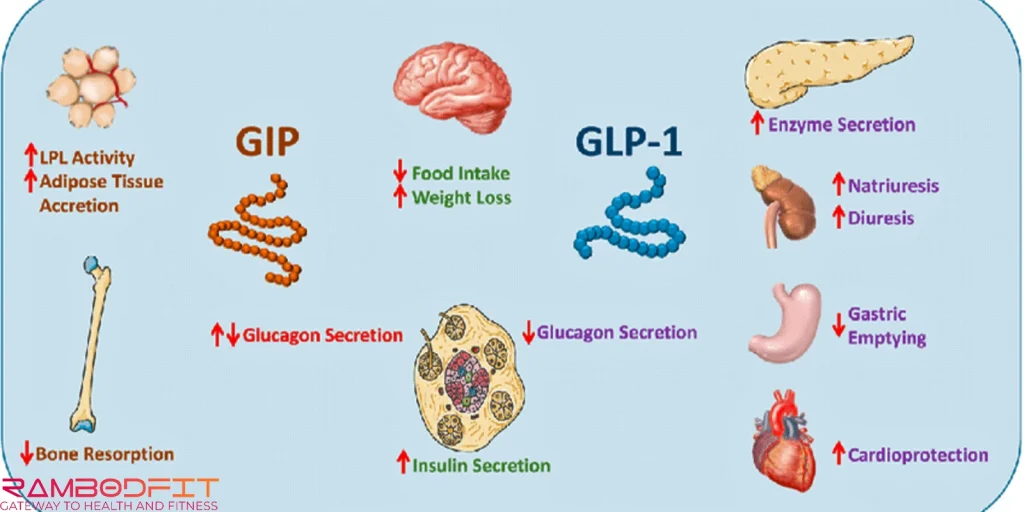


I first encountered GLP-1 and GIP benefits while scrolling through a Reddit fitness forum late one night. A guy claimed he had lost 25 pounds in three months without lifting a single weight. He credited a weekly injection for the results. At first, I thought it sounded like one of those overhyped miracle weight-loss solutions.
But as I dug deeper, my curiosity grew—not just about its role in diabetes management, but also its growing buzz in fitness and bodybuilding circles where people always chase science-backed ways to get ahead.
GLP-1 and GIP benefits might not be the usual terms you hear in the fitness world. These treatments, which focus on incretin hormones, were first created to control blood sugar in people with diabetes. But now, they are being used to help with losing fat, reducing hunger, and keeping muscle.
Both everyday gym-goers and serious athletes are starting to notice them. Is it possible for a diabetes medication to change the game in body recomposition and prep for competitions? Research and personal stories seem to hint that it could.
As always at Rambodfit, we’ll explore the GLP-1 and GIP benefits scientifically. Let’s dive in.
Table of Contents

The word “incretin” comes from blending “insulin” and “secretion.” Hormones like GLP-1 (Glucagon-Like Peptide-1) and GIP (Gastric Inhibitory Polypeptide) are produced in the gut and are released after eating. They help control metabolism by boosting insulin release from the pancreatic beta cells, which manage blood sugar levels. Basically, GLP-1 and GIP benefits act like messengers guiding the body to handle glucose better and work more.
GLP-1 and GIP benefits have an impact on microvascular glucose delivery. They play a role in moving nutrients, such as glucose, into tissues like muscle and fat. This boosts how the body divides and uses nutrients, making these hormones valuable not just in managing diabetes.
GLP-1 and GIP benefits may also interest athletes aiming to fine-tune metabolism and make the most of nutrient use. Their potential effects on body composition and athletic performance are gaining attention in sports science.
Let’s take a closer look at these fascinating hormones.
This powerful hormone boosts insulin release depending on glucose levels. It works when blood sugar goes up, which helps reduce the risk of low blood sugar compared to other diabetes treatments. GLP-1 has several helpful effects:
Using GLP-1 agonists brings several positive outcomes. People often eat smaller portions, stay satisfied for longer hours, and keep steady energy levels all day. I chatted with two hobbyist bodybuilders who tried semaglutide while cutting weight. One called it “a built-in appetite governor,” and the other said it gave them control over eating habits they never had before, without the usual energy slumps from cutting calories.
GIP, or Gastric Inhibitory Polypeptide, uses a glucose-dependent process to boost insulin release, much like GLP-1 does. However, it influences other unique metabolic pathways as well. Researchers have paid less attention to GIP compared to GLP-1.
Though GIP has gained focus in the scientific community. Studies have shown its ability to lower nausea when combined with medicines based on GLP-1. This finding has created new treatment options to help patients who have faced issues with the side effects of GLP-1 agonists.
The scientific world has been buzzing about dual agonists – compounds that target and activate both GLP-1 and GIP receptors at the same time.
These new drugs look very promising. They might even work better than older single-receptor treatments by offering greater metabolic benefits and fewer side effects. This two-in-one mechanism marks an important step forward in treating metabolic conditions.

Tirzepatide, sold as Mounjaro, brings a major change to metabolic medicine. It is the first drug to work on both GIP and GLP-1 receptors at the same time. This approach has caused a big change in how diabetes and obesity are treated, showing results not seen before in medical studies.
Research examining Tirzepatide has shown surprising benefits such as:
To maintain insulin sensitivity and handle hunger, athletes and fitness buffs in weight-cut or competition prep phases may find Tirzepatide useful. This mix has shown its value in managing body composition goals.
Jastreboff AM and her team (2022) examined the effectiveness and safety of tirzepatide in individuals with type 2 diabetes. Their work offers groundbreaking insights on managing blood sugar and body weight. PubMed: 35658024
Type 2 Diabetes: A Clear Match
Strong research backs treatments using GLP-1 and GIP benefits for managing Type 2 diabetes. These drugs help lower blood sugar, improve how insulin works after eating, and lead to noticeable weight loss. GLP-1 and GIP benefits do all this while keeping the risk of low blood sugar quite low. People can shed extra weight without needing to work out. However, keeping muscle intact means putting effort into regular strength training.
A good example is a client named Ray. He tried Tirzepatide treatment while being monitored by a doctor. Ray worked a desk job and exercised, yet he managed to lose 18 pounds in just two months. Later, a DEXA scan showed he lost a small amount of lean muscle. He fixed this by starting a proper resistance training plan.
Type 1 Diabetes: A Gray Zone
Research on Type 1 diabetes hasn’t progressed as much, but a major 2019 clinical trial brought hopeful findings. It showed lower insulin needs and fewer hypoglycemic events. Doctors, though, stress the importance of being cautious. GLP-1 therapies in people with Type 1 diabetes demand strict medical supervision because of how insulin and incretin activity interact in complicated ways.
Here’s the fascinating part.
Losing Fat & Feeling Full
During the cutting phase, controlling hunger turns into a tricky psychological and physical hurdle that can make or ruin competition prep. GLP-1 agonists have a huge effect on this by boosting how full someone feels. They work by targeting specific brain areas tied to appetite control, like the hypothalamus and brainstem. This advanced brain-focused method allows athletes to stick to calorie deficits without facing intense cravings or mental exhaustion, which are common struggles during these cycles. It makes the cutting process easier to handle.
Protein Intake Struggles
There is an important point to keep in mind here. GLP-1 agonists slow down the process of food leaving the stomach because of how they work in the body. This means food stays in the stomach longer. While this slowdown helps people feel full for a longer time, it creates a problem. Athletes might find it harder to eat enough protein because their appetite could decrease too much. Protein is crucial to maintain muscle when they are cutting calories.
Veteran bodybuilders rely on detailed methods to tackle this issue. They track **their protein intake each day ** and focus on when and how it’s absorbed. Top athletes often adjust by incorporating protein shakes in liquid form at specific times. They follow planned amino acid routines and choose different types of protein with unique digestion rates. This helps optimize nutrients without causing nausea or discomfort from medications.
Bulking or Cutting
These medications offer little value in bulking phases because they reduce appetite. This makes it hard to eat enough calories to meet the needed surplus. On the other hand, athletes can find them game-changing during contest prep or when preparing for weight-class sports. They help control calorie intake with accuracy while avoiding the mental and physical stress that often triggers harmful binge-and-restrict habits.
Athletes thinking about using these drugs need to know about several often-reported side effects that they must handle.
One interesting way to deal with side effects is by using both GIP and GLP-1 together, like in the drug Tirzepatide. This dual-activator method seems to lessen nausea by interacting with gut receptors tied to vomiting. It may work better for individuals who are more prone to discomfort.
Not everyone handles these medications the same way. Athletes looking into this option need to take a cautious path. They should begin with the smallest dose, track how their body reacts, and work with a trusted sports doctor who understands hormones and boosting performance.

GLP-1 and GIP benefits like Tirzepatide do more than just help with diabetes. They are starting a new direction in managing metabolism, connecting the field of endocrinology with competitive sports. This opens up new possibilities to manage body composition with greater precision.
The GLP-1 and GIP benefits can help with fat loss is clear, but these drugs work as advanced tools, not quick fixes, for bodybuilding. When used, they can boost results and work well alongside a detailed training plan and specific nutrition strategy.
Still, athletes should realize that skipping regular resistance workouts or not keeping track of protein intake could harm muscle growth and lead to losing progress they’ve worked hard to achieve.
Think about these compounds like a trusted gym partner. They help make tough lifts safer and offer solid support, but they should never take the place of the hard work needed to build and grow muscles.
The focus should be on treating these substances as tools to optimize performance, not as shortcuts or solo answers to achieving fitness goals.
Yes, but you need to eat enough protein and stick to regular resistance training. These drugs are great for burning fat, but won’t keep your muscles safe without the right support. The GLP-1 and GIP benefits are real if you have a proper diet.
There’s not a lot of long-term data on athletes yet. Most reported side effects seem to involve the digestive system. However, how these drugs affect hormones in healthy people over time still needs more research. It’s best to be careful and use them under a doctor’s supervision. GLP-1 and GIP benefits can be real if consumed properly.
Tirzepatide works through a dual mechanism that might improve feelings of fullness while lowering the chances of side effects. However, its higher price and its status as a newer option in the market make it something to think about. People’s reactions to these medications differ a lot, making it necessary to find the right fit for each individual. GLP-1 and GIP benefits can actually help.